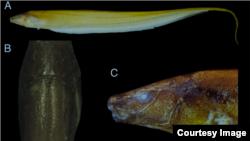Scientists say they have discovered a new genus and species of electric knifefish in the Negro River of Brazil.
The Procerusternarchus pixuna, is a small fish, ranging in size from 75 mm 138 mm, and the voltage they discharge is so small that it’s measured in microvolts, meaning a human would not be able to detect the electric current.
To put that in perspective, an electric eel, which is in the same order of species can emit up to 600 volts of electrical discharge.
Like the other fish in this genus, the Procerusternarchus pixuna uses its electric discharge mainly to locate other fish.
According to Professor Cristina Cox Fernandes at the University of Massachusetts Amherst a co-author of a paper describing Procerusternarchus pixuna, the fish do not swim in schools. In fact, they stay away from one another to avoid jamming each other’s electrical discharge. She added that male and females are able to change the amplitude of the discharge so as not to jam each other.
Just two decades ago, there were less than 100 species of electric fish documented, but that number has nearly doubled today, researchers said.
Last year, researchers at the University of Toronto Scarborough discovered another, previously unknown species of electric fish, the Akawio penak. The “thin eel-like” fish was discovered in shallow, murky water in the upper Mazaruni River area in northern Guyana.
Fernandes, along with with Adília Nogueira and José Antônio Alves-Gomes of the Instituto Nacional de Pesquisas da Amazônia (INPA), Brazil, say that as more electric fish are discovered, scientists will develop a better understanding of how these species have changed over time.
The Procerusternarchus pixuna was described in the current issue of the journal Proceedings of the Academy of Natural Sciences of Philadelphia.
The Procerusternarchus pixuna, is a small fish, ranging in size from 75 mm 138 mm, and the voltage they discharge is so small that it’s measured in microvolts, meaning a human would not be able to detect the electric current.
To put that in perspective, an electric eel, which is in the same order of species can emit up to 600 volts of electrical discharge.
Like the other fish in this genus, the Procerusternarchus pixuna uses its electric discharge mainly to locate other fish.
According to Professor Cristina Cox Fernandes at the University of Massachusetts Amherst a co-author of a paper describing Procerusternarchus pixuna, the fish do not swim in schools. In fact, they stay away from one another to avoid jamming each other’s electrical discharge. She added that male and females are able to change the amplitude of the discharge so as not to jam each other.
Just two decades ago, there were less than 100 species of electric fish documented, but that number has nearly doubled today, researchers said.
Last year, researchers at the University of Toronto Scarborough discovered another, previously unknown species of electric fish, the Akawio penak. The “thin eel-like” fish was discovered in shallow, murky water in the upper Mazaruni River area in northern Guyana.
Fernandes, along with with Adília Nogueira and José Antônio Alves-Gomes of the Instituto Nacional de Pesquisas da Amazônia (INPA), Brazil, say that as more electric fish are discovered, scientists will develop a better understanding of how these species have changed over time.
The Procerusternarchus pixuna was described in the current issue of the journal Proceedings of the Academy of Natural Sciences of Philadelphia.








